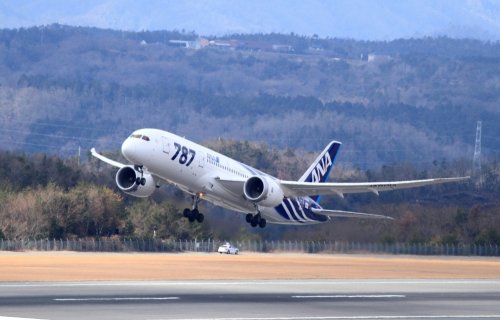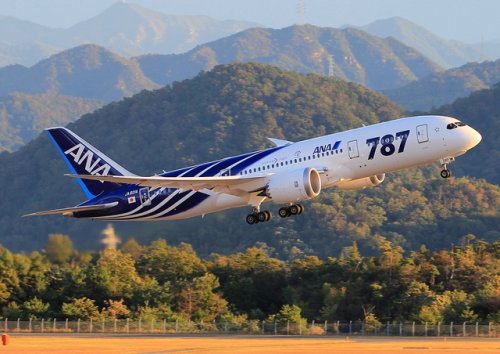Battery problems plaguing Boeing's B787 Dreamliner may be tied to extreme cold
August 05, 2014
By RYUJI KUDO/ Staff Writer
A draft report compiled by the government's Japan Transport Safety Board concludes that the smoldering batteries on an All Nippon Airways Co.'s B787 airliner during a flight last year were most likely caused by the deterioration of cells from the bitter cold.
The incident occurred on Jan. 16, 2013, when one of the batteries on a B787 operated by ANA began smoldering in mid-air above Shikoku island.
The aircraft, en route from Yamaguchi-Ube Airport, Yamaguchi Prefecture, to Tokyo's Haneda Airport, was forced to make an emergency landing at Takamatsu Airport in Kagawa Prefecture.
The U.S. aircraft manufacturing giant Boeing Co.'s newest airliner, also dubbed the Dreamliner, has been involved in a series of battery-related problems.
The innovative B787 is the world's first airliner to extensively utilize lithium-ion batteries. Two such batteries produced by GS Yuasa Corp., an electronics manufacturer based in Kyoto, are installed in each aircraft.
But according to aviation sources, the liquid electrolytes in these batteries were found to deteriorate at lower temperatures, resulting in reduced conductivity.
The extreme coldness of the winter air also causes a phenomenon known as lithium plating, in which the metallic lithium dissolved in the battery's electrolyte is deposited on the surface of the electrodes. This can lead to a disastrous connection of the anodes and cathodes through a continuous metallic path that bypasses the wall separating the two electrodes, causing a short circuit.
The draft pointed out how the inconsistency in the voltage when recharging the batteries contributed to the abrupt deterioration of the batteries as well.
The board plans to conclude that the "smoking was not the result of a singular stimulant, but a combination of multiple causes," in the final report, which is planned for release after September.
A Japan Airlines Co. B787 also experienced problems in January 2013 when its batteries caught fire at Boston's Logan International Airport.
Investigations held by the board in collaboration with the U.S. National Transportation Safety Board concluded that a phenomenon known as thermal runaway, in which short-circuiting batteries become too hot to control, had occurred in both the ANA and JAL cases.
Following the two incidents, the U.S. Federal Aviation Administration and the Japanese transport ministry ordered carriers operating the airliners to ground all B787s. The Dreamliners were unable to fly for about three months.
Although Boeing issued measures to prevent further battery-related problems following the incidents, batteries on another JAL B787 were found to be giving off smoke while preparing for takeoff at Tokyo's Narita Airport in January 2014.
By RYUJI KUDO/ Staff Writer



